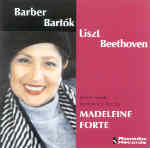Sonically speaking, these live 1993/94 concert performances are of more than adequate archival quality, but they’re not up to the industry’s best standards. That said, you still get a cogent sense of pianist Madeleine Forte’s considerable dynamic range and, more importantly, her commanding virtuosity and impressive musicianship. She makes the daunting jumps and meaty chord sequences in the Barber Sonata first movement sound utterly easy, and her brisk, playfully shaded Allegro Vivace reminds me of Earl Wild’s similarly puckish reference account. She maintains the Adagio’s processional bass lines in perfect proportion to the rest of the keyboard writing and delineates the fugue as crisply and clearly as anyone could want, if not quite matching Horowitz’s thunder and swing or John Browning’s tenderness in softer moments.
Swing, however, is the operative word concerning Forte’s way with the Bartók Suite, and she pays heed to all of the composer’s subtle cross-rhythmic effects and quirky accents without a trace of percussiveness. She occasionally overpedals Liszt’s Liebesträume and does not keep the melody in consistent perspective with the accompanimental filigree. The F minor Etude, though, has marvelous improvisatory sweep and poetry, even if the climaxes are somewhat held back compared to, say, Kissin’s tigerish ferocity. Forte’s Appassionata charts a fleet, headlong course that collectors familiar with Serkin, Schnabel, Gulda, and the famous first-movement film clip featuring Myra Hess will respond to with positive ears. To be sure, the piano tone turns jangly and diffuse in loud, heavily scored passages, but I tend to blame that on the instrument and the engineering rather than on the pianist. Sonic considerations aside, this is the best playing I’ve heard from Madeleine Forte on disc.
































